#king carlos i of portugal
Photo
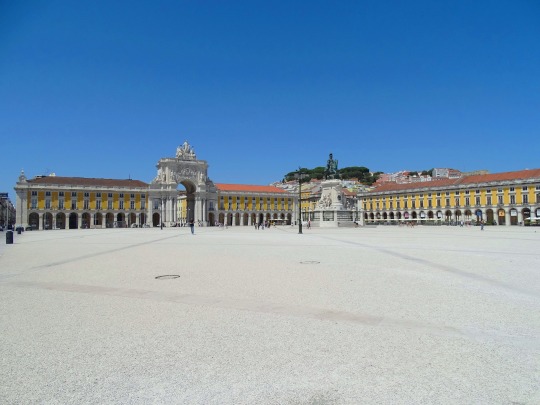





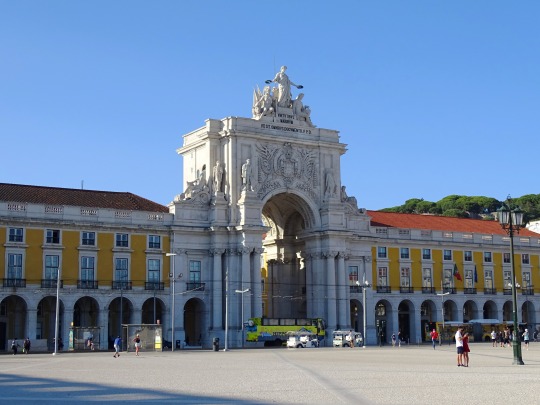



On 1 February 1908, the Praça do Comércio was the scene of the assassination of Carlos I, the penultimate King of Portugal.
#King José I by Machado de Castro#Praça do Comércio#assassination#died#killed#Carlos I#Lisbon#Lisboa#Portugese history#Portugal#vacation#115th anniversary#architecture#cityscape#Arco Triunfal da Rua Augusta#Rua Augusta Arch#Victor Bastos#Célestin Anatole Calmels#summer 2021#sculpture#Southern Europe#public art#tourist attraction#landmark
26 notes
·
View notes
Text
WANNA LEARN SOME HISTORY???
Cool because I have a test tomorrow and I want to write abt it >:3
So let's say we are in the beautiful year of 1870. You are a germanic state trying to unite to other germanic states so you can form a massive empire.
Now let's say you are France. You see a powerful nation being born and decide " Well that's threatening " So you know what you have to do: boicot it ofc
But then they realise what you have been trying to do and invade your country as revenge. They do it with ease, and they go to your simbol of power in Paris, The Versalles (idk how to write that in English lol) and establish themselves as a nation: The Germanic-Prussian empire (again, the term in portuguese I think is "Império Germânico-Prussiano" and Idk how that translates.) And then just leave, but keeping a little part of your country with them. ( portugues expression incoming- Uma espinha entalhada no orgulho francês)
So after that there is a ton of peace and cultural flourishment, in am epoque designated for "Belle Èpoquè" in wich there is like a looot of beautiful things. Let's say the social side of it. People started having more fun since they worked less and the middle class was emerging rapidly. The cinemas, Caffès, operas, theatres, films/movies, amusement parks, all were created at this time. Also penicillin, as they were ton of medical advances at that time. They created the telefone and the plane and the car and WOW everything is beautiful.
In art we see two main themes -> women and nature (often together). Details are suuuuuper important. Clothes get more baloney and plain, with big puff shoulders that were so big that they had to be stored with pillows inside in order not to lose shape. Buildings are BEAUTIFUL and everything is really. It's a great time for humans.
Then people start to get greedy. Africa, still unexplored in its interior is object of many country's desire. They are 5 main countrys who had colonies before: Portugal, Spain, England, France and Holland. 3 new countries want to have some colonies too: Italy, Germany and Belgium.
In 1885 a conference is hosted in Berlim to divide Africa between European countries, being two main things that are considered:
Historical right- given to the 5 starters for beig there the longest/ already having stuff there
Ocupation right- If the country is willing to explore, populate, and take care of that area. The ones who got the most following this right are the 3 big rich countries: England, France and Germany.
Overall the ocuparion right is prioritized, so Portugal comes up with The Pink Map ( no specific reason for the name it was just the color lmao), wich claims to Portugal the lands between the Angolan and Mozambican coast. This is approved.
BUT the English ofc wanted to build a giant train line that connected Cairo and Cape Town, so they needed our ( Portugal's )territory, and since they had like massive belic power the got us and Ultimatum, so that we either leaved or got into war. The king at the time, D. Carlos gave in and England NEVER MADE THE TRAIN LINE WHAT OMG.
Yeyeyey ty for reading this big history lesson bubye!!!
WISH ME LUCK ON MY TEST <3
#guess-ill-dye#history#histoire#history facts#test#<3#rant post#infodump#information#belle epoque#art noveau#art#history addict#<3333333333333333333333333333
11 notes
·
View notes
Text
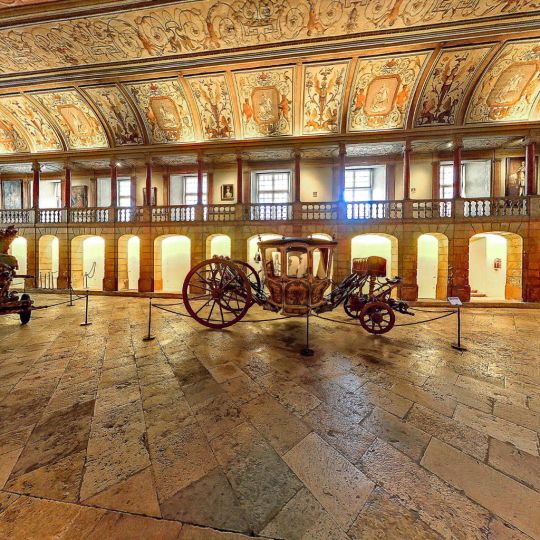
Portugal 360. The National Carriage Museum in Lisbon was founded in 1905 on the initiative of Amelia d'Orléans (the last Queen of Portugal), wife of King Carlos I. Her goal was to collect, preserve and present to the public an important collection of vehicles belonging to the Royal Court. The museum is located in the building of the Royal Riding School, built by the Italian architect Giacomo Azzolini in 1787
11 notes
·
View notes
Note
We all know spain and austria were married for the longest time, could you talk about it
Just short of 200 years! And yet I don't know if I can say they actually spent much time together. King Charles V split it off because it was just too much for one man to get to grips on, so if they were one household it was for... I don't know how to define it actually. Either 1506 if you go with a Habsburg becoming King of Spain or 1519 where politically the HRE, Austria, BeNeLux and Spain all united. Personal or political union, usual story... Point is, it politically split in 1522 (when Charles ceased to be Archduke of Austria and gave it to his brother), or 1556 (where he gave up Holy Roman Emperor and gave it to his brother), or... I don't know. It's complicated. So, if you're going by that metric definition of marriage, they at worst didn't even manage five years. If you're going by the name and name alone, then yeah, you've got 200 years together.
I think we know in canon Antonio's household was BeNeLux, Romano and I assume where relevant Portugal. Austria had HRE, Czechia/Bohemia and Slovakia, Hungary and Veneziano, amongst others. I think it's important to remember that the "Let others wage war, but thou, O happy Austria, marry; for those kingdoms which Mars gives to others, Venus gives to thee" quote refers not just to the intermarriages with Spain, but also Bohemia, Hungary plus the pressures on Poland and France. Also Austria did absolute buckets of fighting at this time.
Austria is literally designed to be a wall. That mid point in Europe no-one east can cross. I think therefore his attentions were always elsewhere. In the same vein, Antonio was equally focused elsewhere. Roderich can complain 'I won't tolerate bigamy' but bruh. Bruh. I guess it depends where Erzsi is that day. Mayhaps bigamy is a nono but open marriage is fine. Who knows. The idea of them only actually being one household for like four years but being tangled in this awful mess of a family for 200 is very funny to me. You really can't find more diametrically opposed characters.
Completely off topic ramble under the cut
If people ever want some not English period dramas to watch then going from Maximilian for why the Habsburgs ended up in BeNeLux (including the most upsetting depiction of what happened to Mary of Burgundy in that yes she fell from her horse and had her spine crushed and took days for her to die and what am I supposed to feel with her final lines being 'life is not our own we simply borrow it' and telling her husband 'live a little longer then you will follow me' like siocbfdgfszxvcbngfsxcv okay) and then from there watch the Spanish Isabel, The Broken Crown, and then Carlos, rey emperador for the merger and splintering of the Spanish and Austrian territories. You can keep going actually... including the fantasy time travel El ministerio del tiempo which honestly 10 out 10 insanity if you want to hop across Spanish history yes including exactly what you would expect from the World War Two episodes and an episode where Phillip II decides to become King of the World following the defeat of the Armada honestly it's great it's dumb it's doctor who minus aliens. Spain has done so many period dramas it's honestly great. Margaret of Austria wishes she was this pretty (sorry that's mean it's not like she had any choice in the matter in what was happening to the genes of her family).


7 notes
·
View notes
Text
Our Contestants
1: Maria Leopoldina of Austria, First Empress of Brazil
2 Dona Maria I of Portugal
3: Dona Maria II of Portugal
4: Isabel, Princess Imperial of Brazil
5 Carlota Joaquina de Bourbon
6: João I, Duke of Bragança
7 João IV, King of Portugal
8: Afonso I, Duke of Bragança
9: Fernando I, Duke of Bragança
10: Jaime I, Duke of Bragança
11: Teodósio I, Duke of Bragança
12: Teodósio II, Duke of Bragança
13: Afonso VI of Portugal
14 Pedro II of Portugal
15: João V of Portugal
16: João VI of Portugal
17: Pedro II of Portual
18 Pedro I of Brazil/ IV of Portugal
19: Miguel I of Portugal
20: Pedro V of Portugal
21: Luís I of Portugal
22: Carlos I of Portugal
23: Manuel II of Portugal
24 Dom Pedro II of Brazil
25: Teresa Cristina, Empress of Brazil.
26: Catherine de Bragança, Queen Consort of England, Scotland, and Ireland
27: Infante Dom Manuel, Candidate for the throne of Poland
28: José I of Portugal
29: Carol II of Romania (Carlos II in Portuguese)
30: Ferdinand I of Romania
31: Infantá Antonia de Bragança, Princess Consort of Hohenzollern
32: Amélie of Leuchtenberg
33: Infanta Isabel Maria, Regent of Portugal
34: Mariana Vitória of Spain, Queen Consort of Portugal
35: Maria Francisca of Savoy (Consort to Afonso VI and Pedro II)
36: Maria Pia of Savoy (Queen-Consort to Luís I of Portugal)
6 notes
·
View notes
Photo
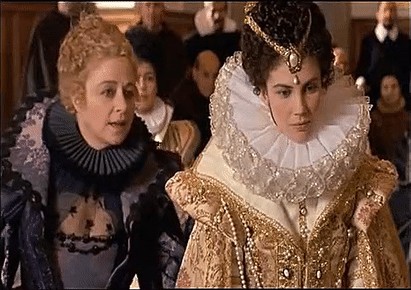







Philip IV of Spain and Elisabeth of France
When Elisabeth of France, the eldest daughter of King Henri IV and Marie de Medici, arrived at the Spanish court, Elisabeth under went significant change from a carefree young girl to a serious politician in her own right, acquiring political experience that would serve the crown well during the last years of her life. As the political situation grew more complicated, Elisabeth responded competently to the important matters that Philip IV gradually began to delegate to her. Elisabeth of France’s period of governance came at a crucial moment for the Spanish Monarchy, from 1642 to 1644, when it was undergoing an intense economic, military, and political crisis. At this same time, the king’s favourite and minister Count-Duke of Olivares fell from power,creating a vacuum that the queen hurried to fill, and her political influence notably increased after January 1643.
Even though the power she wielded was necessarily delegated by Philip IV, in times of political crisis, her role crucially influenced the Spanish government. While Olivares’s fall had facilitated her assuming this role, it was the queen’s extraordinary political skills and, in particular, her success in negotiating financial support and military maneuvers that proved she was equal to the task of governing in the king’s absence. The first time the queen had been given power were the years 1626 and 1632, when the king left Madrid to summon the Cortes or Parliaments of Aragon, Valencia, and Catalonia.
In August 1627, the queen’s role took on greater importance, as the king became seriously ill, precipitating one of the most critical moments of his reign. Given what seemed to be the likelihood of his death, Philip wrote a will and testament according to which Elisabeth, who was pregnant at the time, would become regent until the unborn child, if a son, would reach majority. If a daughter, she was to marry her paternal uncle, the infante Carlos, and the couple would inherit the crown. The king recovered the first week of September.

The revolt of Catalonia, which began on June 7, 1640, was followed by the revolt of Portugal in December that same year. These unprecedented rebellions within the Iberian peninsula coincided with other armed conflicts through out Europe in which Spain participated. France had declared war on Spain just five years earlier, and since then, Philip IV had mentioned several times that he wished to go to the battlefront. News that Louis XIII had visited the French troops in March 1642 caused Philip to visit his as well. He departed from Madrid in April 1642, leaving Elisabeth and her son, Baltasar Carlos, in tears. In addition to her activities with the Junta de Gobierno, the queen attended council meetings and royal ceremonies in the company of Baltasar Carlos, who had just turned thirteen. Her actions as head of government served as an example to the young prince. The queen took charge of the government for nearly eight months, until the king returned in early December.
Elisabeth had two main concerns during her final year as governor: first, she had to find the monies to supply the armies fighting both the Catalonian rebels and the French; and second, she had to secure funds for the defense of the Portuguese border. In both cases she was assisted by Chumacero, the Council president, with whom she consulted daily. Thanks in part to her efforts, the army at long last achieved several victories in 1644. Philip and Elisabeth wrote to each other regarding government affairs, just as Charles V and Empress Isabel had done a century earlier. Elisabeth of France retained an active role in governance until September 1644, when the first symptoms of erysipelas, the disease that would eventually lead to her death, first appeared. A few days after his wife’s death, in a letter to the queen’s close friend, the Countess of Paredes, the king wrote,
“Countess, you may judge how I have reached this point; in one day I have lost my wife, my friend, my helper and counselor in all my labors. Surely I must be made of bronze, for I have not lost my mind or my life.”
Source:
Alejandra Franganillo Álvarez, Isabel de Borbón and the Governance of the Spanish Monarchy
#Philip IV of Spain#Felipe IV de España#Isabel de Borbón#Elisabeth of France#couples in history#Spanish history
46 notes
·
View notes
Photo
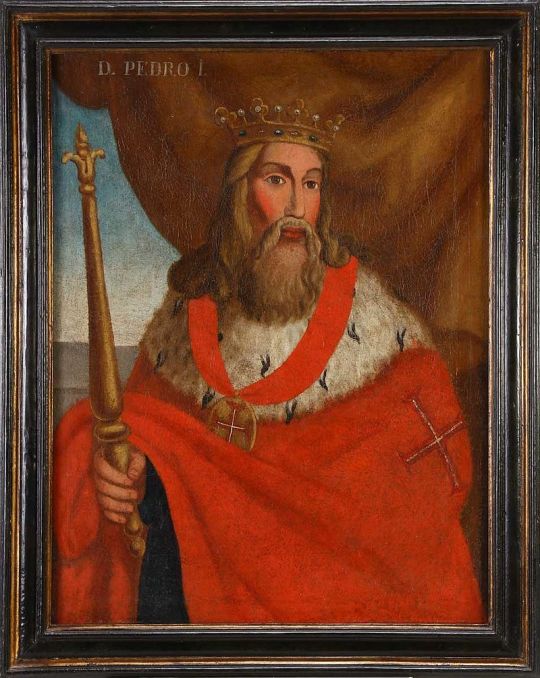









Royal Birthdays for today, April 8th:
Peter I, King of Portugal, 1320
Philip IV, King of Spain, 1605
Mary Stuart, English Princess, 1605
Marie Caroline of Austria, Crown Princess of Saxony, 1801
Christian IX, King of Denmark, 1818
Albert I, King of Belgium, 1875
Carlos Hugo, Duke of Parma, 1930
Iskandar of Johor, Sultan of Johor, 1932
Lalla Amina, Princess of Morocco, 1954
Leah Isadora Behn, Daughter of Martha Louise of Norway, 2005
#marie caroline of austria#christian ix#albert i#mary stuart#philip iv#peter i#carlos hugo of parma#Iskandar of Johor#lalla amina#Leah Isadora Behn#royal birthdays#long live the queue
20 notes
·
View notes
Photo
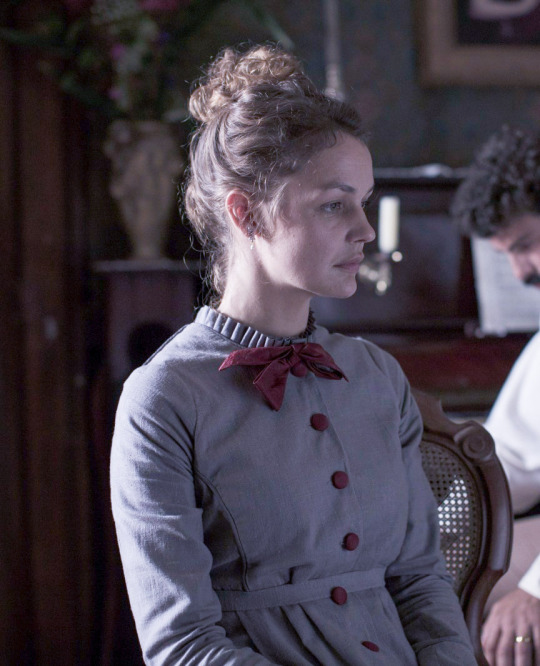

Luise Heyer as Maria Leopoldina of Austria, the Empress Consort of Brazil, Queen Consort of Portugal and Archduchess of Austria
Dona Maria Leopoldina of Austria (22 January 1797 – 11 December 1826) was born Caroline Josepha Leopoldine Franziska Ferdinanda of Habsburg-Lorraine in Vienna, Austria, Holy Roman Empire. She was the daughter of Holy Roman Emperor Franz II and Empress Maria Theresa of Naples and Sicily. In 1817 the Archduchess married Prince Dom Pedro of Braganza (12 October 1798 – 24 September 1834), heir to Portugal, later the Emperor Dom Pedro I of Brazil and King Dom Pedro IV of Portugal. The couple had 7 children: Queen Maria II of Portugal, Miguel, Prince of Beira, João Carlos, Prince of Beira, Princess Januária of Brazil, Princess Paula of Brazil, Princess Francisca of Brazil and Emperor Dom Pedro II of Brazil. On September 2, 1822 while she was the Acting Princess Regent of the Kingdom of Brazil in the absence of her husband Maria Leopoldina signed the Decree of Independence, declaring Brazil separate from Portugal. She died at age 29 in 1826 after a miscarriage. As Acting Regent Maria Leopoldina was the first woman to govern an independent Brazil, the first empress consort of the country, the first empress of the Americas and the first woman to govern an independent American country.
Victoria Guerra as Amélia of Leuchtenberg, the Empress Consort of Brazil and Duchess of Braganza
Dona Amélia of Leuchtenberg (31 July 1812 – 26 January 1873) was born Amélie Auguste Eugénie Napoléonne de Leuchtenberg in Milan, Kingdom of Italy. She was the daughter of Eugène de Beauharnais, Duke of Leuchtenberg and Princess Augusta of Bavaria, Duchess of Leuchtenberg. She was the second wife of Emperor Dom Pedro I of Brazil after their marriage in 1829 and they had one child, the Princess Maria Amélia of Brazil. After Dom Pedro I abdicated the Brazilian crown, Amélia accompanied her husband back to Europe. They held the titles of Duke and Duchess of Braganza until Pedro’s dead in 1834. Amélia died in Lisbon at the age of 60 in 1873.
A VIAGEM DE PEDRO | PEDRO, BETWEEN THE DEVIL AND THE DEEP BLUE SEA (2021). Dir. Laís Bodanzky
#a viagem de pedro#perioddramaedit#filmedit#movieedit#weloveperioddrama#worldcinemaedit#perioddramasource#onlyperioddramas#historicwomendaily#periodedits#braziliansource#cinematv#cinemapix#fyeahmovies#motionpicturesource#filmtv#filmtvdaily#userperioddrama#femaledaily#femalecharacters#flawlessbeautyqueens#historyedit#women in history#period drama#pedro between the devil and the deep blue sea#brazilian cinema#brazilian movies#mine#mine: edit#brazilian stuff
74 notes
·
View notes
Text
Amerus in the wonderland
I came up with three versions. In all three, Ivan is Alice. Alfred in the first is the Cheshire Cat, in the second is the White Rabbit, in the third is the Mad Hatter.
First version. Ivan followed the white rabbit Felix and so he ended up in a wonderland ruled by the Queen of Hearts Natalia and her henpecked husband, the King of Hearts Tolys. Natalya falls in love with Ivan at first sight and wants him to marry her; she can divorce Tolys or make Ivan her second husband. Of course, Ivan doesn’t want to marry her, she gave him a choice: either he marries her or he will be beheaded. Ivan chooses the second, but right during the execution he is saved by the Cheshire cat Alfred and naturally Ivan falls in love with his savior. Now Ivan lives with Alfred in the house of Duchess Nyo!Sweden (I don’t know what they usually call her), who is Alfred’s owner (this is a wonderland. Here you can keep catboys/girls as pets), Tino is her cook and husband, they have the child, Peter, is adopted. His biological father is Arthur, and his mother is Elizabeth (Nyo! England), but his mother dies during childbirth, Arthur abandoned him and he was taken in by the Duchess and her husband. Other roles: Netherlands (I don't know what his name is) - the caterpillar, Arthur - the Mad Hatter, Francis - the March Hare, Matthew - the Dormouse. They have a threesome, top Arthur and his two bottoms.
Second version. Ivan followed the White Rabbit Alfred and thus ended up in Wonderland. The Queen of Hearts Berwald wants to execute Ivan, even the merciful King of Hearts Tino has nothing against execution. Fortunately, Alfred is almost like a son to Berwald and Tino, so he managed to talk them out of execution. Ivan does not want to return to his world, otherwise he will be married to Natalya there, so he remains in Wonderland, now he will be together with the white rabbit. Other roles: Gilbert - Cheshire Cat, Monica - Duchess, her cook husband - Feliciano, they have no child, Sadık - Caterpillar, Antonio - Mad Hatter, Portugal (I don't know what the name is) - March Hare, Lovino Dormouse. Gilbert is Lovino's boyfriend, Antonio is Port's boyfriend.
Third version. This time Ivan ran after the white rabbit Gilbert and ends up in Wonderland. The Queen of Hearts Francis was afraid of Ivan, because it’s not every day that aliens from another world walk in Wonderland, so he wanted to execute him, the White Rabbit Gilbert also wants this execution, only the King of Hearts Matthew was against it, but no one listened. This time, Ivan escapes on his own and meets the tea trio. Alfred is the Mad Hatter, Arthur is the March Hare, and Kiku is the Dormouse. They will have amerus and asakiku next. Other roles: Felix - the Cheshire cat, Natasha - the duchess, her chef husband - Tolis, without a child, Carlos - the caterpillar.
#amerus#aph#hws#hetalia#aph america#hws america#aph russia#hws russia#crossover#plot bunny#alternative universe
4 notes
·
View notes
Text
How Did it Go So Wrong for RHOA?

In the end of a year I like to reflect on the Bravo year we’ve had and try to break down the most memorable moments from the Real Housewives franchise.
Sadly, I couldn’t think of one single moment on season 15 of RHOA that could compete with the other shows. Not even with honourable mentions!
But not only that! Multiple fans reported on empty seats at the panel for RHOA at BravoCon!
That is a cause for pause. This is bad.
How the former It show on Bravo, the legendary RHOA, end up being forgettable and irrelevant?!
Kenya Moore claimed to have some answers for us in her interview with Carlos King, though. She simply said:
“Choices. Casting choices.”
When Kenya and Porsha Williams joined the show, they had to go through tests and a lot of filming before they were earned with joining the group.
Being a housewife was like getting into a high society club, but then Bravo started to give out the title to just about anyone.
It’s no longer a privilege to be a housewife.
And it doesn’t seem like the women on the show wants it good enough or appreciate it enough to give their blood, sweat, and tears.
It has become deflecting, deceiving, acting, and lying. Kenya actually broke the fourth wall in Portugal and told the women that they were ruining the show.
Drew Sidora and Marlo Hampton were awful additions. They’ve been allowed to lie on the show, and it has been infuriating to watch.
I felt like Sanya Richards Ross had potential as she’s funny and showing her life and adding something unique to the show, she hasn’t wowed me.
And don’t get me started on Courtney Rhodes.
I was one of those who thought that Marlo deserved a chance of trying out as a housewife, but the only reason she was upgraded was because the casting was in shambles.
How did it come to this?!
Kenya’s interview with Carlos was like a whistleblower. A cry for help. And Bravo should thank her for showing them how bad things has gotten.
#Real Housewives of Atlanta#RHOA#BravoCon2023#BravoCon23#Kenya Moore#Carlos King#Porsha Williams#Drew Sidora#Marlo Hampton#Sanya Richards Ross#Courtney Rhodes
2 notes
·
View notes
Text
19 / 12 / 2023
🇺🇸🇬🇧 ENGLISH / ANGLAIS 🇬🇧🇺🇸
GAME WITH HISTORICAL CHARACTERS :
RULERS DURING THE 16th CENTURY
For this new game with historical characters, I chose to take 4 sovereigns who are considered the most powerful men of their time: Henry VIII Tudor, King of England and Ireland; Francis I of Valois, King of France; Charles V, King of Spain and Emperor of the Holy Roman German Empire (and many other titles); Sultan Süleyman the Magnificent, longest-reigning leader of the Ottoman Empire.
They met (except Süleyman the Magnificent, but he allied himself with Francis I of France), made alliances with each other against each other. They were all beautiful in their youth but did not necessarily become more beautiful when they were older (Süleyman aged well, Francis I of France too, but Henry VIII of England became obese and Charles V's face lengthened and he lost weight).
In the television series about their reign, they are played by tall and muscular actors (Francis I was giant in size, but Henry VIII was muscular in his youth and Süleyman was considered Magnificent as much for his physique as for his reign). All four of them are the embodiment of their country's power, their reign symbolizing a golden age for their country.
They were also all four seducers, two of them having been rather faithful to their true love (Süleyman renounced his concubines to marry the Ukrainian slave Roxelane, renamed Hürrem; Emperor Charles V only deceived only once his wife and cousin the beautiful Isabella of Portugal), while two others were very unfaithful to their wives (Francis I humiliated his two wives Claude of France and Eleonore of Austria, sister of Charles V, by having favorites; Henry VIII divorced or beheaded his wives).
_
🇨🇵 FRANÇAIS / FRENCH 🇨🇵
JEU AVEC DES PERSONNAGES HISTORIQUES :
SOUVERAINS DU XVIe SIÈCLE
Pour ce nouveau jeu avec des personnages historiques, j'ai choisi de prendre 4 souverains qui sont considérés comme les hommes les plus puissants de leur temps : Henry VIII Tudor, Roi d'Angleterre et d'Irlande ; François Ier de Valois, Roi de France ; Charles Quint de Habsbourg, Roi d'Espagne et Empereur du Saint-Empire Romain Germanique (et plein d'autres titres) ; le Sultan Süleyman le Magnifique, chef au plus long règne de l'Empire Ottoman.
Ils se sont rencontrés (sauf Süleyman le Magnifique, mais il s'est allié à François Ier de France), ont fait des alliances les uns avec les autres les uns contre les autres. Ils ont tous été beaux dans leur jeunesse mais n'ont pas forcément embelli (Süleyman a bien vieilli, François Ier de France aussi, mais Henry VIII d'Angleterre est devenu obèse et le visage de Charles Quint s'est allongé et il a maigri).
Dans les séries télévisées portant sur leur règne, ils sont incarnés par des acteurs grands et musclés (François Ier était géant en taille, mais Henry VIII était musclé dans sa jeunesse et Süleyman était considéré comme Magnifique autant pour son physique que pour son règne). Ils sont tous les quatre l'incarnation de la puissance de leur pays, leur régne symbolisant un âge d'or pour leur pays.
Ils étaient aussi tous les quatre des séducteurs, deux d'entre eux ayant été plutôt fidèle à leur véritable amour (Süleyman a renoncé à ses concubines pour épouser l'esclave ukrainienne Roxelane, renommée Hürrem ; l'Empereur Charles Quint n'a trompé qu'une seule fois son épouse et cousine la belle Isabelle du Portugal), alors que deux autres ont été très infidèles à leurs épouses (François Ier a humilié ses deux épouses Claude de France et Éléonore d'Autriche, sœur de Charles Quint, en ayant des favorites ; Henry VIII a divorcé ou décapité ses épouses).
🇬🇧 You have to chose between these versions : All of them are shown as loyal to their lover (depending if they prefer their mistress or wife), fucking rough (Henry VIII, Francis I) or tenderly (Carlos V, Süleyman). Towards their servants, they are cocky and arrogant (Francis I in Carlos Rey Emperador is shown as someone who likes being served), or who treats them as objects or sometimes as friends (Henry VIII), who doesn't even looks at them (Carlos V) or who treats them well as long as they are obedient.
🇨🇵 Vous devez choisir parmi ces versions :
1. King Carlos V of Spain, Emperor of the Holy Roman Empire (played by the Spanish actor Álvaro Cervantes in the Spanish tv series CARLOS REY EMPERADOR, 2015)


2. Henry VIII Tudor, King of England and Ireland (played by the Irish actor Jonathan Rhys-Meyers in THE TUDORS, 2007-2010)


3. King Francis I of France (Alfonso Bassave in CARLOS REY EMPERADOR (2015-2016))


4. Sultan Süleyman of the Ottoman Empire (played by the Turkish actor Halit Ergenç in the Turkish tv series MUHTEŞEM YÜZYIL, 2011-2014)


@jonathanrhysmeyersworld @turkishfeet @leftprogrammingroadtripdean @tidodore2 @faggotdreams @rainykpoptravelcreator @gayhopefullove @innerpiratefun @lovefanfiction01
4 notes
·
View notes
Text
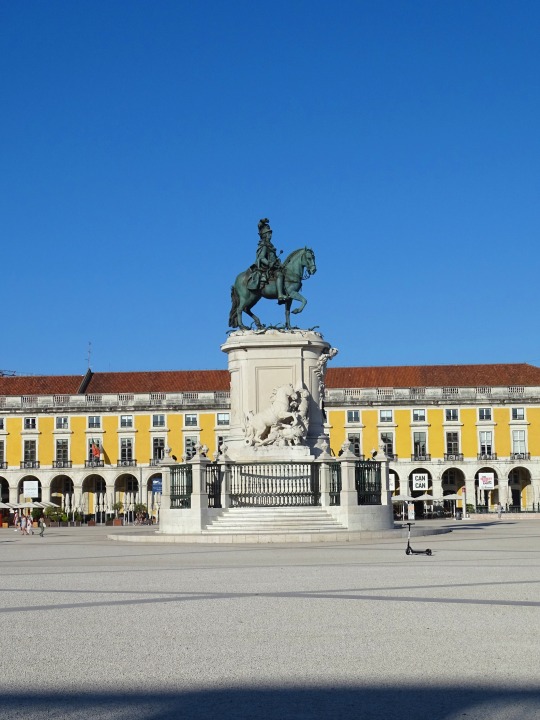
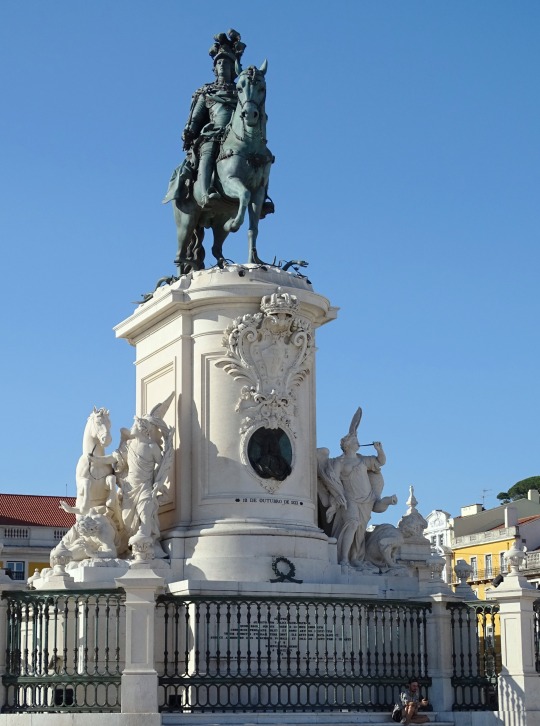
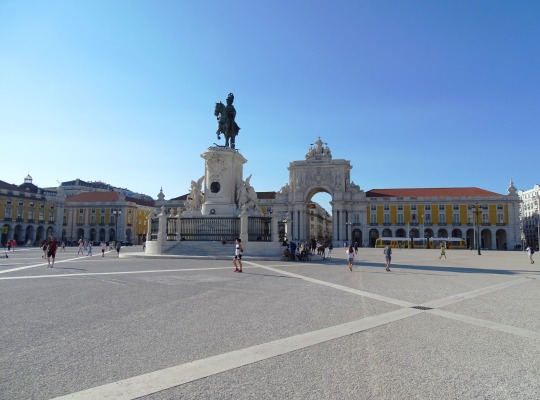
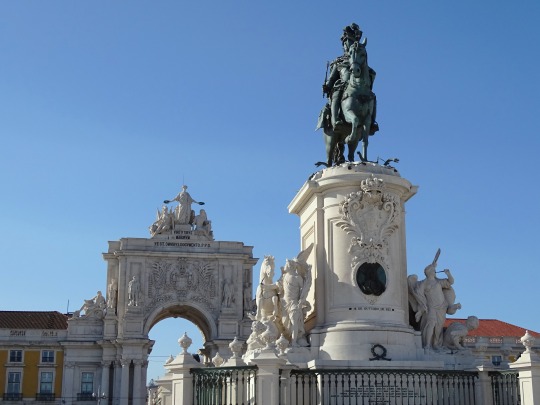
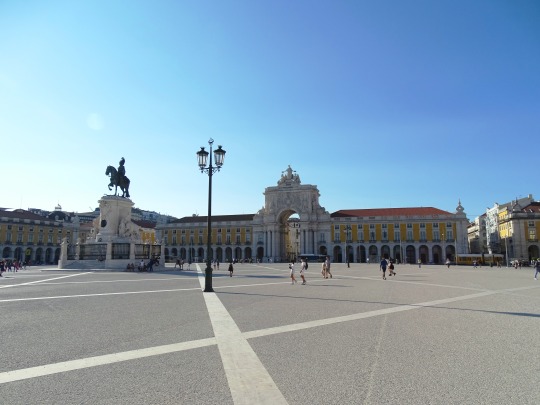
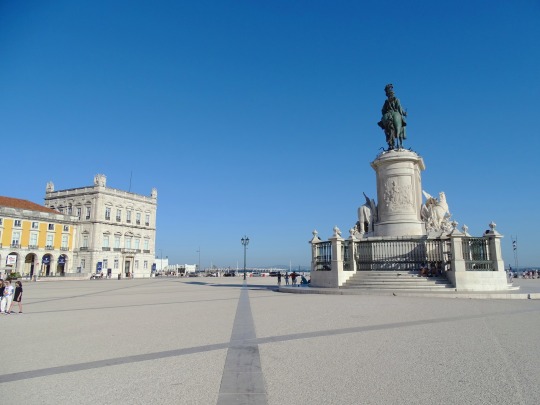
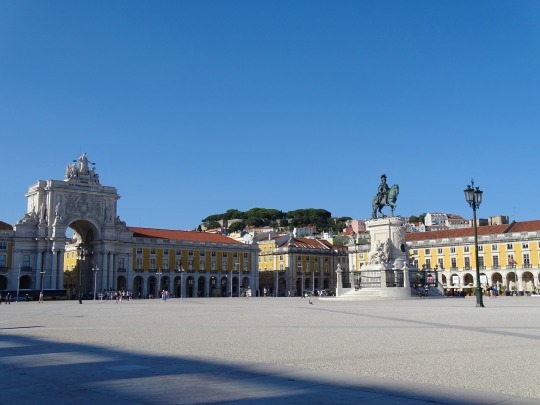
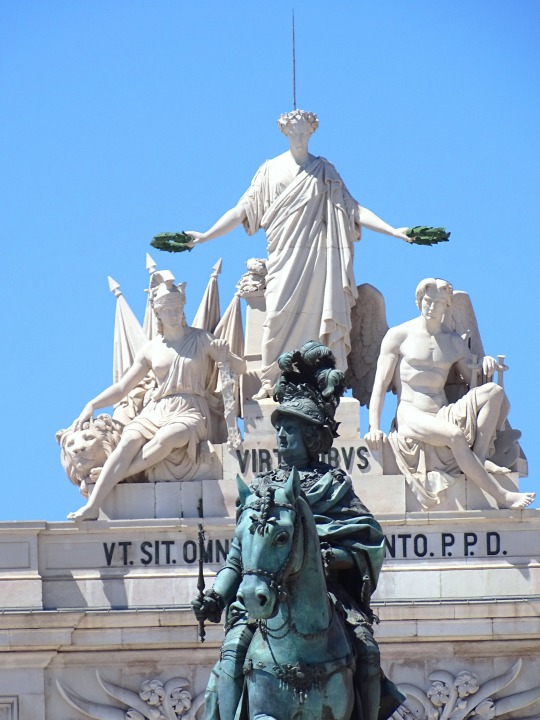
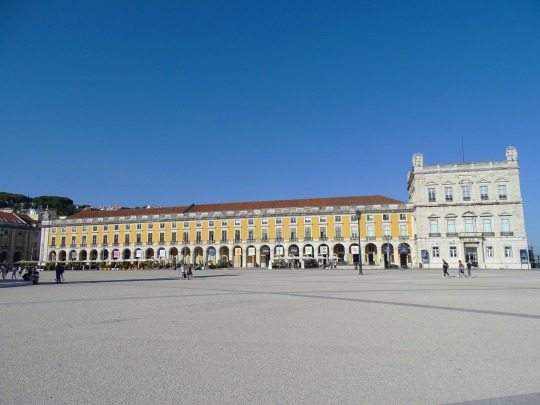


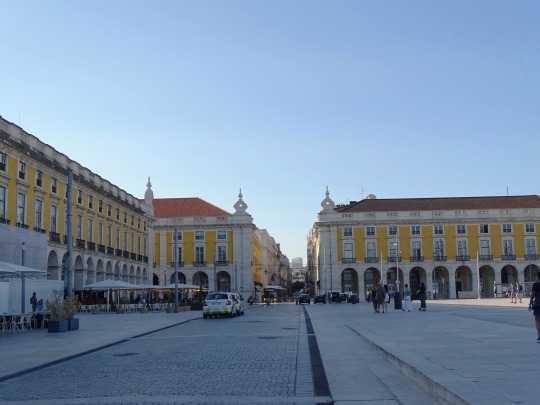
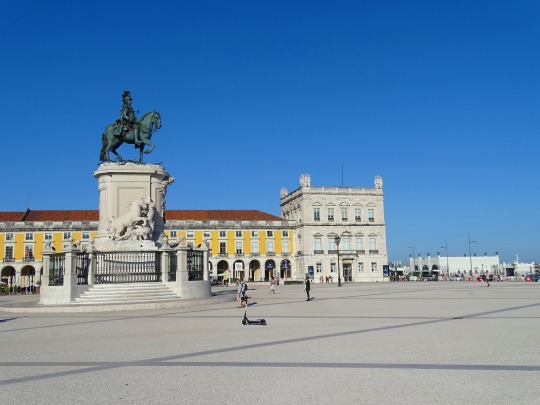
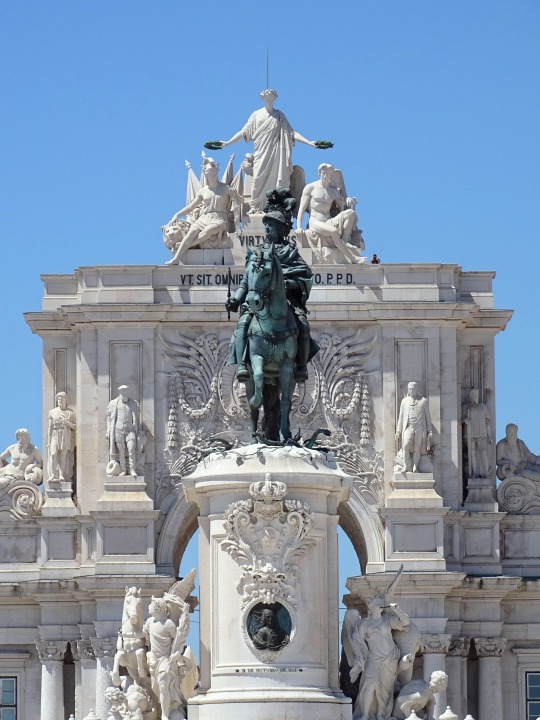
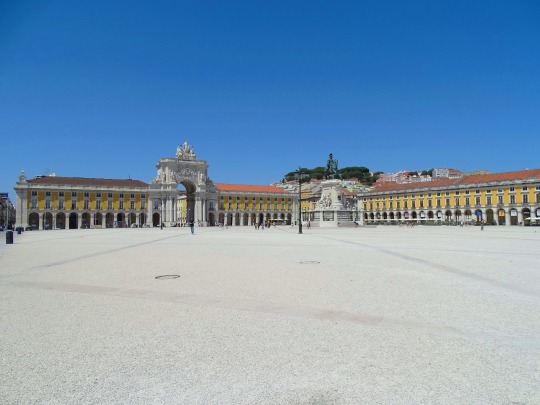
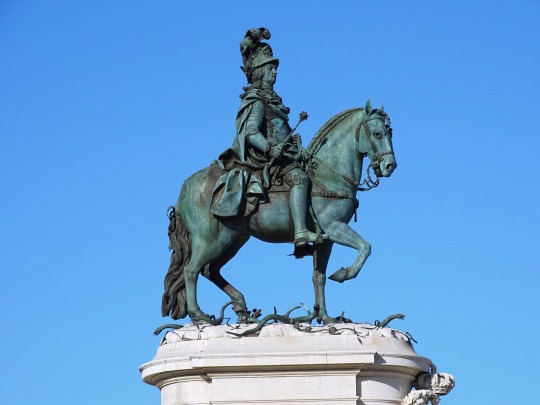



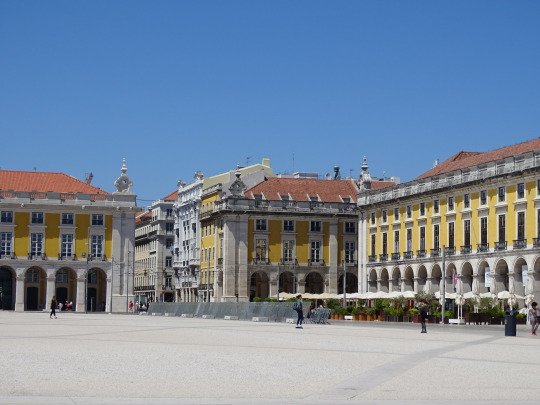

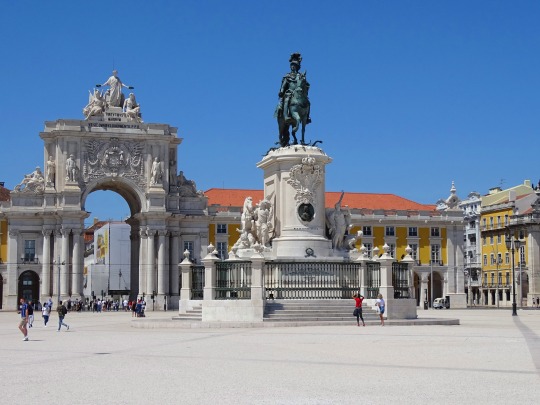
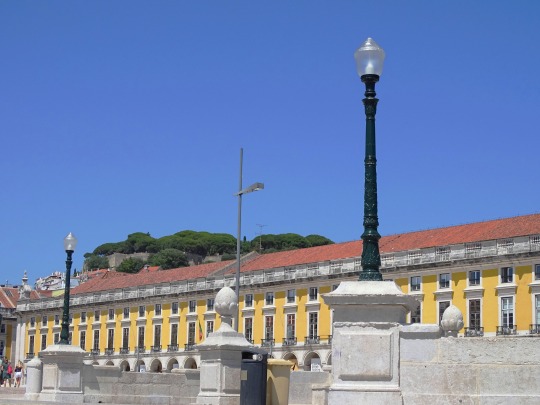

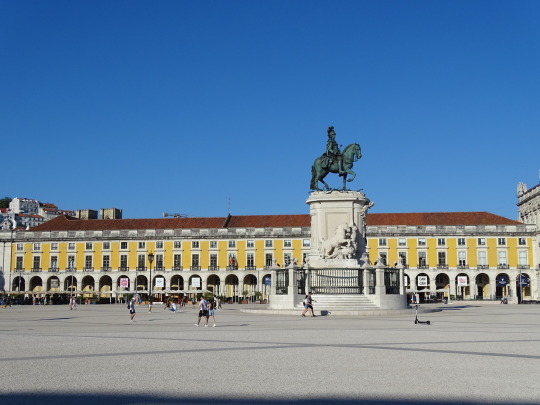
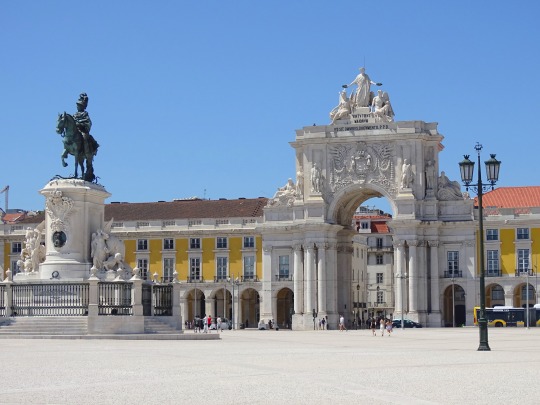
On 1 February 1908, the Praça do Comércio was the scene of the assassination of Carlos I, the penultimate King of Portugal.
#King José I by Machado de Castro#Praça do Comércio#assassination#died#killed#Carlos I#Lisbon#Lisboa#Portugese history#Portugal#vacation#anniversary#architecture#cityscape#Arco Triunfal da Rua Augusta#Rua Augusta Arch#Victor Bastos#Célestin Anatole Calmels#summer 2021#sculpture#Southern Europe#public art#tourist attraction#landmark
2 notes
·
View notes
Text
I ship John III of Portugal and Leonor of Austria from the Spanish historical drama Carlos Rey Emperador
@leopard-skin-pillbox-hat-ok
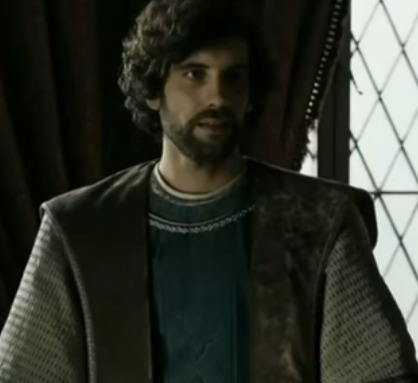

Leanor was supposed to be bethrothed to John III but she got married to his father (and her uncle) Manuel I instead. Manuel I got Leonor of Austria pregnant.
When Manuel I died and John III became king of Portugal, John III and Leonor became lovers.(or they were already lovers.. or they loved each other... coz they were of the same age and also first cousins)
John III asked Charles V, who is Leonor's brother and Holy Roman Emperor/King of Castille, for her hand in marriage. Charles V refused. Leonor was ordered to return to Castile after she gave birth to hers and Manuel I daughter.



John III became a bitter and melancholic throughout his life.
Leonor never got to see her daughter again and was eventually got married to Francis I of France who didn't even lay with her :(
in a cruel twist... Charles V ordered their youngest sister Catherine to marry John III instead.
royalty is miserable business, folks.
#carlos rey emperador#leonor of austria#john iii of portugal#João III#miserable eldest daughter leonor of austria
5 notes
·
View notes
Text
Events 5.9
328 – Athanasius is elected Patriarch of Alexandria.
1009 – Lombard Revolt: Lombard forces led by Melus revolt in Bari against the Byzantine Catepanate of Italy.
1386 – England and Portugal formally ratify their alliance with the signing of the Treaty of Windsor, making it the oldest diplomatic alliance in the world which is still in force.
1450 – 'Abd al-Latif (Timurid monarch) is assassinated.
1540 – Hernando de Alarcón sets sail on an expedition to the Gulf of California.
1662 – The figure who later became Mr. Punch makes his first recorded appearance in England.
1671 – Thomas Blood, disguised as a clergyman, attempts to steal England's Crown Jewels from the Tower of London.
1726 – Five men arrested during a raid on Mother Clap's molly house in London are executed at Tyburn.
1864 – Second Schleswig War: The Danish navy defeats the Austrian and Prussian fleets in the Battle of Heligoland.
1865 – American Civil War: Nathan Bedford Forrest surrenders his forces at Gainesville, Alabama.
1865 – American Civil War: President Andrew Johnson issues a proclamation ending belligerent rights of the rebels and enjoining foreign nations to intern or expel Confederate ships.
1873 – Der Krach: The Vienna stock exchange crash heralds the Long Depression.
1877 – Mihail Kogălniceanu reads, in the Chamber of Deputies, the Declaration of Independence of Romania. The date will become recognised as the Independence Day of Romania.
1901 – Australia opens its first national parliament in Melbourne.
1915 – World War I: Second Battle of Artois between German and French forces.
1918 – World War I: Germany repels Britain's second attempt to blockade the port of Ostend, Belgium.
1920 – Polish–Soviet War: The Polish army under General Edward Rydz-Śmigły celebrates its capture of Kiev with a victory parade on Khreshchatyk.
1926 – Admiral Richard E. Byrd and Floyd Bennett claim to have flown over the North Pole (later discovery of Byrd's diary appears to cast some doubt on the claim.)
1927 – The Old Parliament House, Canberra, Australia, officially opens.
1936 – Italy formally annexes Ethiopia after taking the capital Addis Ababa on May 5.
1941 – World War II: The German submarine U-110 is captured by the Royal Navy. On board is the latest Enigma machine which Allied cryptographers later use to break coded German messages.
1942 – The Holocaust in Ukraine: The SS executes 588 Jewish residents of the Podolian town of Zinkiv (Khmelnytska oblast. The Zoludek Ghetto (in Belarus) is destroyed and all its inhabitants executed or deported.
1946 – King Victor Emmanuel III of Italy abdicates and is succeeded by Umberto II.
1948 – Czechoslovakia's Ninth-of-May Constitution comes into effect.
1950 – Robert Schuman presents the "Schuman Declaration", considered by some to be the beginning of the creation of what is now the European Union.
1955 – Cold War: West Germany joins NATO.
1960 – The Food and Drug Administration announces it will approve birth control as an additional indication for Searle's Enovid, making Enovid the world's first approved oral contraceptive pill.
1969 – Carlos Lamarca leads the first urban guerrilla action against the military dictatorship of Brazil in São Paulo, by robbing two banks.
1974 – Watergate scandal: The United States House Committee on the Judiciary opens formal and public impeachment hearings against President Richard Nixon.
1979 – Iranian Jewish businessman Habib Elghanian is executed by firing squad in Tehran, prompting the mass exodus of the once 100,000-strong Jewish community of Iran.
1980 – In Florida, United States, Liberian freighter MV Summit Venture collides with the Sunshine Skyway Bridge over Tampa Bay, making a 1,400-ft. section of the southbound span collapse. Thirty-five people in six cars and a Greyhound bus fall 150 ft. into the water and die.
1980 – In Norco, California, United States, five masked gunmen hold up a Security Pacific bank, leading to a violent shoot-out and one of the largest pursuits in California history. Two of the gunmen and one police officer are killed and thirty-three police and civilian vehicles are destroyed in the chase.
1987 – LOT Flight 5055 Tadeusz Kościuszko crashes after takeoff in Warsaw, Poland, killing all 183 people on board.
1988 – New Parliament House, Canberra officially opens.
1992 – Armenian forces capture Shusha, marking a major turning point in the First Nagorno-Karabakh War.
1992 – Westray Mine disaster kills 26 workers in Nova Scotia, Canada.
2001 – In Ghana, 129 football fans die in what became known as the Accra Sports Stadium disaster. The deaths are caused by a stampede (caused by the firing of tear gas by police personnel at the stadium) that followed a controversial decision by the referee.
2002 – The 38-day stand-off in the Church of the Nativity in Bethlehem comes to an end when the Palestinians inside agree to have 13 suspected terrorists among them deported to several different countries.
2018 – The historic defeat for Barisan Nasional, the governing coalition of Malaysia since the country's independence in 1957 in 2018 Malaysian general election.
2020 – The COVID-19 recession causes the U.S. unemployment rate to hit 14.9 percent, its worst rate since the Great Depression.
2022 – Russo-Ukrainian War: United States President Joe Biden signs the 2022 Lend-Lease Act into law, a rebooted World War II-era policy expediting American equipment to Ukraine and other Eastern European countries.
2 notes
·
View notes
Photo
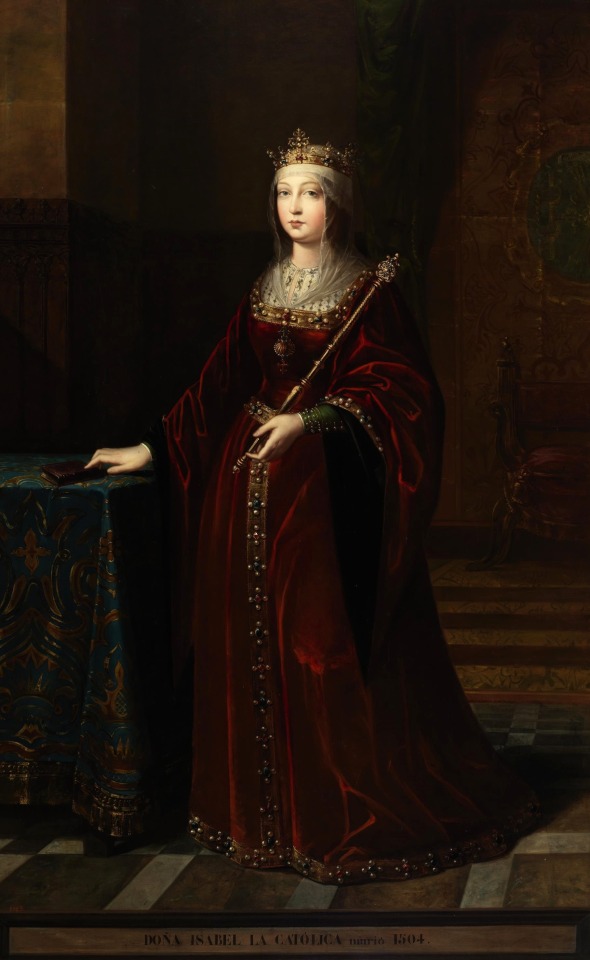

~ “Ysabel de Trastamara, Her Royal Catholic Majesty, Queen Lady Ysabel I of Castile, Mother of Hispanic (Madrigal of the Altas Torres, April 22, 1451 – Medina del Campo, November 26, 1504).Queen of Castile and Lion (1474-1504), Queen of Granada (1492-1504) and Queen Consort of the Crown of Aragon (1479-1504). Daughter of John II of Castile and Isabel of Portugal, Ysabel I of Castile was only three years old when her brother Enrique IV signed the Castilian crown (1454).In 1468, the monarch, a man of weak and indecisive character, recognized Princess Elizabeth as heir to the throne in the covenant of the Bulls of Guisando, by which he deprived of his successor rights to his daughter, Princess Juan, called the Beltraneja, pu This who was supposed to be daughter of Beltran of the Cave, Duke of Albuquerque.In order to consolidate their political position, the advisers of Ysabel the Catholic agreed to her wedding to Prince Ferdinand, firstborn of John II of Aragon, a link that was held in secret, in Valladolid, on October 19, 1469. The following year, annoyed by this marriage, Enrique IV decided to disinherit Ysabel and rehabilitate Juana in his status as heiress, who was married to Alfonso V of Portugal.The consequence was that, at the king's death, in 1474, a sector of the nobility proclaimed Elizabeth sovereign of Castile, while another nobility faction recognised Joan (1475), which marked the beginning of a bloody civil war.Despite the Portuguese monarch's help to the Beltraneja, the succession conflict was decanted in Ysabel's favor in 1476, in the wake of the grave defeat inflicted on its supporters by Prince Fernando of Aragon at the Battle of Toro. The fighting, however, took place on the Castilian-Portuguese border until 1479, in which the treaty of Alcaçobas meant the final recognition of Ysabel as queen of Castile by Portugal, as well as delimiting the area of expansion Spanish on the Atlantic coast of Africa. That same year, on the other hand, the death of John II made possible the accession of Fernando II to the throne of the Crown of Aragon, and the subsequent dynastic union of Castile and the Crown of Aagon. The master lines of the joint policy developed by Ysabel I and Fernando II were the entrenchment and expansion of real power, the stimulation of the economy, the conclusion of the total reconquest to the Muslims of the peninsula and the strengthening of the Catholic faith.To consolidate and prestige the monarchy, the queen implanted the Holy Brotherhood, institution charged with ensuring the stability of public order and the administration of justice (1476), abolished the prerogatives bestowed on the nobility by Enrique IV (1480) and made the Royal Council the principal governing body of the kingdom, to the detriment of the Courts.In the economic aspect, Ysabel the Catholic sanctioned the public treasury through a strict tax system and encouraged the development of sheep livestock and wool trade. In addition, he knew how to channel the military and expansive tradition of Castile toward the conquest of the Nazari kingdom of Granada, the last Islamic stronghold on the Peninsula (1492), and the war against the North African Muslims, which was snatched by Melilla (1497). Nevertheless, Isabelle's greatest foreign policy achievement was undoubtedly the financing of the expedition that would culminate in the discovery of America by Christopher Columbus (1492).In religious matters, lastly, Ysabel the Catholic carried out a profound ecclesiastical reform with the help of Cardinal Cisneros, created the Inquisition Court to oversee Catholic Orthodoxy (1478) and culminated the process of unification r selective with the expulsion of the Jews (1492) and the change (1502). At his death, happened on November 26, 1504 due to cancer, the Castilian throne passed to his daughter Juana, mother of the future monarch Charles I of Spain/Carlos V of the Holy German Roman Empire.“ ~
2 notes
·
View notes
Text
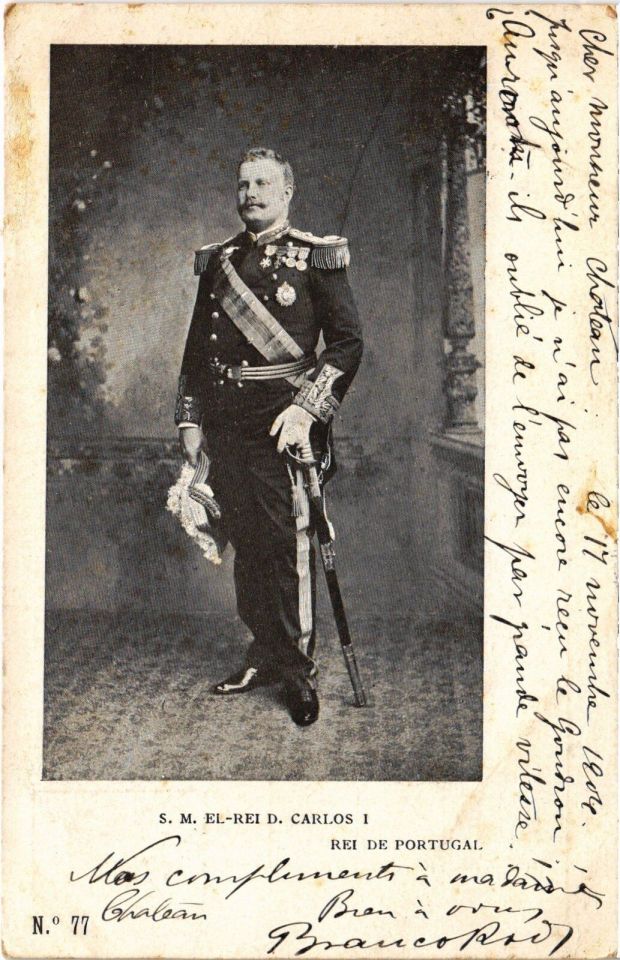
Carlos Fernando Luís Maria Victor Miguel Rafael Gabriel Gonzaga Xavier Francisco de Assis José Simão, King Carlos I of Portugal
Portuguese vintage postcard, mailed in 1904 to Bordeaux, France
#vintage#tarjeta#francisco#france#maria#xavier#briefkaart#fernando#bordeaux#postcard#photography#gonzaga#1904#assis#postal#gabriel#carte postale#sepia#carlos fernando luís maria victor miguel rafael gabriel gonzaga xavier francisco de assis josé simão#ephemera#portugal#victor#historic#portuguese#carlos#king#ansichtskarte#postkarte#rafael#simo
1 note
·
View note